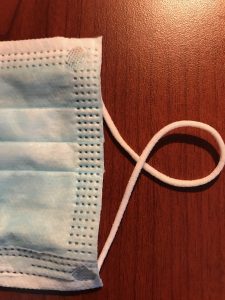CSP Team Note: This post was originally published on Novant Health’s Healthy Headlines. We thank them for allowing us to share it with you. To subscribe to Novant Health’s Healthy Headlines newsletter, click here. Click here to find a physician. Novant Health is also offering a self-guided assessment tool to help patients determine if they should seek care for COVID-19. (Note: This assessment is not a substitute for professional medical advice, diagnosis or treatment and should not be used if patients are experiencing a life-threatening emergency.)
Knowing how to properly wear a mask is important when it comes to keeping your family safe.
Masks or homemade cloth face coverings recently became a hot commodity after the Centers for Disease Control and Prevention (CDC) recommended that we should all start wearing one when out in public.
One of the ways Novant Health is supporting masking is by donating 225,000 masks to the communities it serves. They’re being distributed to patients across the state, and they are also available at respiratory assessment centers at Novant Health Waughtown locations in Winston-Salem and the Novant Health Michael Jordan Family Medical Clinic in Charlotte.
And while we have all become experts at hand-washing and social distancing, there’s still confusion about how and when to wear masks.
We asked family nurse practitioner Yolanda Enrich at Novant Health Adult Primary Care to help set the record straight and keep you and your family safe. See clips below.
Q: Do I really need to wear a mask when out in public?
Yes. Wearing a mask not only helps to protect yourself from COVID-19, but it also helps to protect others. Think of wearing a mask as a selfless act, one in which we are each taking responsibility and doing our part to help protect the most vulnerable members of our community.
Q: Is there a right way to wear my mask?
The mask should fit snugly and cover your nose, mouth and chin. You should also never touch the front of your mask as it might be contaminated. Instead, you should only touch the ear loops or ties on the back when putting the mask on or taking it off.
Take care to always have the same side of the mask facing outward. You don’t want to go into a public place wearing a mask, take it off later, and then put it back on with the front now pressing on your face. Always keep the “clean” side in. And you should also wash your hands before and after use.
Q: How do I get my mask to stop fogging up my glasses?
If you wear a surgical-style mask with elastic loops and find your glasses fogging, cross the ear loops once and then slide around your ear. It may reduce fogging and make breathing a little easier.
Q: Is it OK to pull my mask down around my chin and then pull it back up when I need it?
This is another common misconception that we have noticed. Under no circumstance should you pull your mask down around your chin or take it off and put it back on. This can increase your risk of infection.
Q: Do I need to wear a mask when driving in my car or walking around the neighborhood?
In your car, no. But you should wear a mask anytime you are in a public place and social distancing becomes a challenge.
Q: If I visit family do I need to wear a mask?
When you’re around immediate household family members, you don’t need to wear a mask. But I would still hold off on visiting extended family members. If the visit can’t be postponed or conducted virtually, then I would definitely advise wearing a mask. You should also avoid kissing, hugging or handshakes.
Q: Does my baby need to wear a mask?
According to the CDC, young children under the age of 2 should not wear a mask to prevent the possibility of suffocation. Older children should wear them when around others.
Q: Should I clean or change my mask?
Masks should be routinely changed or washed depending on the frequency of use. Cloth masks can be safely cleaned in a washing machine.
Q: Do I need to wear gloves?
Unless you are a health care provider, you do not need to wear gloves. Gloves can give us a false sense of security and actually result in less frequent handwashing. The big thing to remember is wash your hands often with soap and water and avoid touching your face.
How to Wear a Mask:
Answering Common Mask Questions:
Novant Health
Healthy Headlines
Facebook
Instagram
Twitter
YouTube






